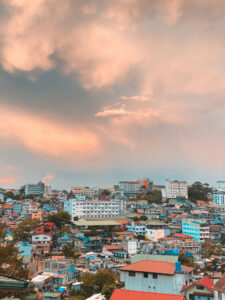 The first time I visited Baguio, I was a child clutching a jacket too big for me, chasing fog between pine trees. Years later, returning as a traveler, the city feels both familiar and new — its cool air unchanged, but its rhythm softer, more thoughtful. Today, Baguio has grown into something beyond the “Summer Capital of the Philippines.” It’s become an artists’ refuge, a slow-living sanctuary, and a city where creativity breathes through every corner. This Baguio travel guide is my way of rediscovering that magic — one café, one market, and one misty mountain morning at a time.
The first time I visited Baguio, I was a child clutching a jacket too big for me, chasing fog between pine trees. Years later, returning as a traveler, the city feels both familiar and new — its cool air unchanged, but its rhythm softer, more thoughtful. Today, Baguio has grown into something beyond the “Summer Capital of the Philippines.” It’s become an artists’ refuge, a slow-living sanctuary, and a city where creativity breathes through every corner. This Baguio travel guide is my way of rediscovering that magic — one café, one market, and one misty mountain morning at a time.
Getting to Baguio
Reaching Baguio has never been easier. The drive from Manila now takes around four to five hours via the TPLEX (Tarlac–Pangasinan–La Union Expressway) and Marcos Highway. I left before sunrise, watching the city lights fade into rolling hills and cool mountain air. If you prefer a hassle-free trip, Victory Liner offers comfortable buses with reclining seats, Wi-Fi, and scenic stopovers. For private travelers, carpool options and van rentals are available on Klook, making spontaneous getaways smooth and scenic.
Once you arrive, the best way to explore Baguio is slowly — whether by walking along Session Road’s sloping streets or riding a jeepney through pine-lined avenues. The city’s elevation (1,540 meters above sea level) gives it a natural chill that never fails to refresh both body and mind.
Creative Corners: Where Art Meets Mountain Light
Baguio’s creative pulse is strongest in its art spaces, where nature and imagination intertwine. My first stop was BenCab Museum, perched on the hillside of Asin Road. As I stepped onto its glass terrace, the view took my breath away — mist hovering over the valley, sunlight glinting off forest streams. Inside, Benedicto Cabrera’s works hung alongside indigenous Cordilleran art and contemporary installations. I found myself lingering before a painting of solitary mountains, feeling both small and infinite.
Next was Ili-Likha Artist Village along Assumption Road — a labyrinth of wood, glass, and recycled art built by filmmaker Kidlat Tahimik. The smell of brewed coffee and grilled vegetables filled the air as local artists painted, sang, and sculpted around me. Every corner seemed alive — walls covered in mosaics, ceilings hung with wind chimes made from scrap metal. It’s less a café and more a community, where creativity flows freely and conversations linger long after the cup is empty.
Just outside the city center lies Tam-awan Village, an artist haven modeled after traditional Ifugao huts. I walked through its uneven paths surrounded by bamboo and ferns, passing by workshops where artisans crafted woodcarvings and handwoven textiles. The air smelled faintly of pine and smoke. It’s not just a museum; it’s a living space that honors indigenous heritage and mountain artistry.
Cafés with Character
 No Baguio travel guide would be complete without coffee. Here, cafés are not just places to eat — they’re sanctuaries. At Arca’s Yard in Ambuklao Road, I settled into a wooden nook overlooking pine-covered hills. The owner, a retired librarian and artist, serves homemade camote pie and local arabica coffee. As I sipped, clouds rolled over the valley below — it felt like being inside a watercolor painting.
No Baguio travel guide would be complete without coffee. Here, cafés are not just places to eat — they’re sanctuaries. At Arca’s Yard in Ambuklao Road, I settled into a wooden nook overlooking pine-covered hills. The owner, a retired librarian and artist, serves homemade camote pie and local arabica coffee. As I sipped, clouds rolled over the valley below — it felt like being inside a watercolor painting.
Downtown, Café by the Ruins remains an icon. Once built among World War II ruins, it’s now a tribute to resilience — serving local favorites like longganisa breakfasts and pan de sal with herbed cheese. I always order their tsokolate batirol — thick, rich, and best paired with rain tapping on the roof.
For something more modern, Hot Cat Specialty Coffee and Vizco’s Café along Session Road mix urban comfort with local flavor. And of course, a slice of Vizco’s strawberry shortcake is a must — creamy, light, and sweet as a Baguio morning.
Markets & Local Finds
 To understand a city, visit its market. The Baguio Public Market near Session Road is an explosion of color and scent — rows of sun-dried flowers, woven baskets, and strawberries piled high beside coolers of fresh milk. I love walking through the vegetable section, where farmers from La Trinidad call out cheerfully as they unpack greens still dewy from harvest. The coffee stalls here sell freshly roasted beans from Benguet — earthy, bold, and perfect for gifts.
To understand a city, visit its market. The Baguio Public Market near Session Road is an explosion of color and scent — rows of sun-dried flowers, woven baskets, and strawberries piled high beside coolers of fresh milk. I love walking through the vegetable section, where farmers from La Trinidad call out cheerfully as they unpack greens still dewy from harvest. The coffee stalls here sell freshly roasted beans from Benguet — earthy, bold, and perfect for gifts.
On weekends, Session Road transforms into a pedestrian market filled with local art, plants, and handmade crafts. I found woven bags from Sagada, upcycled jewelry, and local honey — each stall telling a story of craftsmanship and pride. For classic pasalubong, Good Shepherd Convent still reigns supreme. Their ube jam and strawberry preserves are made by hand, supporting community projects run by the nuns. I’ve brought home countless jars over the years, but each still tastes like a little piece of Baguio.
Where to Stay: Cozy Retreats in the Pines
Choosing where to stay depends on the mood you want. For those who crave art and calm, North Zen Villas and The Forest Lodge at Camp John Hay offer serene mountain views and warm interiors. On one trip, I stayed in a tiny Airbnb cabin near Outlook Drive — pine-scented mornings, wooden decks, and fog that rolled in like clockwork each dusk. It felt like a home suspended in the clouds.
Travelers seeking something artsy should try Kamino Café and Inn, a small retreat built by artists, or Casa Vallejo, one of Baguio’s oldest inns where history meets comfort. For budget explorers, G1 Lodge along Session Road blends minimalist design with local textures — stone, wood, and sunlight.
Wherever you stay, expect the same cool air, cozy blankets, and the faint scent of pine that seems to follow you everywhere in this mountain city.
When to Visit Baguio
Baguio’s charm shifts with the seasons. The coolest months are from December to February, when temperatures can drop below 10°C — perfect for sipping hot chocolate by a window fogged with mist. If you’re after strawberries, plan your trip between November and March, when the fields of La Trinidad are ripe for picking.
For art lovers, February’s Panagbenga Festival transforms the city into a sea of flowers and street performances. In recent years, smaller creative gatherings like Ibagiw: The Baguio Creative Festival have highlighted the city’s UNESCO Creative City status — celebrating everything from weaving and woodcarving to indie music and film. Even in the quiet months, Baguio hums with life — fog rolling over Session Road, artists sketching in cafés, and the smell of pine after rain.
Baguio Beyond Nostalgia
 What struck me most during this trip was how Baguio has evolved. The city I remembered from childhood — all campfires and strawberries — has matured into something richer. The creative energy here isn’t forced; it flows naturally, from murals on old buildings to sculptures rising out of gardens. This isn’t just a mountain retreat anymore; it’s a community built on sustainability and art.
What struck me most during this trip was how Baguio has evolved. The city I remembered from childhood — all campfires and strawberries — has matured into something richer. The creative energy here isn’t forced; it flows naturally, from murals on old buildings to sculptures rising out of gardens. This isn’t just a mountain retreat anymore; it’s a community built on sustainability and art.
Locals are finding ways to protect the environment too. Cafés now use bamboo straws and source produce from nearby farms. Art spaces collaborate with indigenous groups to promote ethical crafts. It’s as if Baguio has found a quiet balance — between growth and preservation, between its past and what it’s becoming.
As I packed to leave, the city sent me off with one last foggy morning. The air was crisp, the trees whispered softly, and I could hear faint church bells from the Cathedral. Baguio remains what it’s always been — a refuge, a muse, a memory in motion.
This Baguio travel guide barely scratches the surface of its spirit. Whether you’re sipping coffee at a hilltop café, tracing art trails, or simply walking among the pines, Baguio invites you to slow down and breathe deeply. The mountain air carries stories — old and new — and each visit writes a different one.
For more highland escapes, read 15 Best Things to Do in Tagaytay for a Cozy Weekend Escape, or plan your Cordillera adventure through the Department of Tourism – Cordillera Region.
In the end, Baguio isn’t just a destination — it’s a feeling. A cool breath of memory, a canvas of pine and light, a gentle reminder that art and nature can thrive together on top of the world.

